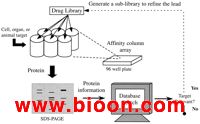蛋白质组学实验指南
互联网
全文下载: http://www.ebioe.com/down/html/down_276.htm
Paul R. Graves
1
and Timothy A. J. Haystead
1
,2
Department of Pharmacology and Cancer Biology, Duke University, 1 , 1 and Serenex Inc., 2 Durham, North Carolina 27710 2
Microbiology and Molecular Biology Reviews, March 2002, p. 39-63, Vol. 66, No. 1
This review is intended to give the molecular biologist a rudimentary
understanding of the technologies behind proteomics and their
application to address biological questions. Entry of our laboratory
into proteomics 5 years ago was driven by a need to define a
complex mixture of proteins (
 36 proteins) we had affinity isolated
that bound specifically to the catalytic subunit of protein
phosphatase 1 (PP-1, a serine/threonine protein phosphatase
that regulates multiple dephosphorylation events in cells) (26).
We were faced with the task of trying to understand the significance
of these proteins, and the only obvious way to begin to do this
was to identify them by sequencing. We then bought an Applied
Biosystems automated Edman sequencer (not having the budget
for a mass spectrometer at the time). Since the majority of
intact eukaryotic proteins are not immediately accessible to
Edman sequencing due to posttranslational N-terminal modifications,
we invented mixed-peptide sequencing (38). This method, described
in detail later, essentially enables internal peptide sequence
information to be derived from proteins electroblotted onto
hydrophobic membranes. Using the mixed-peptide sequencing strategy,
we identified all 36 proteins in about a week. The mixture contained
at least two known PP-1 regulatory subunits, but most were identified
in the expressed sequence tag or unannotated DNA databases and
were novel proteins of unknown function. Since that time, we
have been using various molecular biological approaches to determine
the functions of some of these proteins. Herein lies the lesson
of proteomics. Identifying long lists of potentially interesting
proteins often generates more questions than it seeks to answer.
36 proteins) we had affinity isolated
that bound specifically to the catalytic subunit of protein
phosphatase 1 (PP-1, a serine/threonine protein phosphatase
that regulates multiple dephosphorylation events in cells) (26).
We were faced with the task of trying to understand the significance
of these proteins, and the only obvious way to begin to do this
was to identify them by sequencing. We then bought an Applied
Biosystems automated Edman sequencer (not having the budget
for a mass spectrometer at the time). Since the majority of
intact eukaryotic proteins are not immediately accessible to
Edman sequencing due to posttranslational N-terminal modifications,
we invented mixed-peptide sequencing (38). This method, described
in detail later, essentially enables internal peptide sequence
information to be derived from proteins electroblotted onto
hydrophobic membranes. Using the mixed-peptide sequencing strategy,
we identified all 36 proteins in about a week. The mixture contained
at least two known PP-1 regulatory subunits, but most were identified
in the expressed sequence tag or unannotated DNA databases and
were novel proteins of unknown function. Since that time, we
have been using various molecular biological approaches to determine
the functions of some of these proteins. Herein lies the lesson
of proteomics. Identifying long lists of potentially interesting
proteins often generates more questions than it seeks to answer.
Despite learning this obvious lesson, our early sequencing experiences were an epiphany that has subsequently altered our whole scientific strategy for probing protein function in cells. The sequencing of the 36 proteins has opened new avenues to further explore the functions of PP-1 in intact cells. Because of increased sensitivity, our approaches now routinely use state-of-the-art mass spectrometry (MS) techniques. However, rather than using proteomics to simply characterize large numbers of proteins in complex mixtures, we see the real application of this technology as a tool to enhance the power of existing approaches currently used by the modern molecular biologist such as classical yeast and mouse genetics, tissue culture, protein expression systems, and site-directed mutagenesis. Importantly, the one message we would want the reader to take away from reading this review is that one should always let the biological question in mind drive the application of proteomics rather than simply engaging in an orgy of protein sequencing. From our experiences, we believe that if the appropriate controls are performed, proteomics is an extremely powerful approach for addressing important physiological questions. One should always design experiments to define a selected number of relevant proteins in the mixture of interest. Examples of such experiments that we routinely perform include defining early phosphorylation events in complex protein mixtures after hormone treatment of intact cells or comparing patterns of protein derived from a stimulated versus nonstimulated cell in an affinity pull-down experiment. Only the proteins that were specifically phosphorylated or bound in response to the stimulus are sequenced in the complex mixtures. Sequencing proteins that are regulated then has a meaningful outcome and directs all subsequent biological investigation.
<center> <strong>Definitions</strong> </center>
The term "proteomics" was first coined in 1995 and was defined
as the large-scale characterization of the entire protein complement
of a cell line, tissue, or organism (13, 163, 167). Today, two
definitions of proteomics are encountered. The first is the
more classical definition, restricting the large-scale analysis
of gene products to studies involving only proteins. The second
and more inclusive definition combines protein studies with
analyses that have a genetic readout such as mRNA analysis,
genomics, and the yeast two-hybrid analysis (123). However,
the goal of proteomics remains the same, i.e., to obtain a more
global and integrated view of biology by studying all the proteins
of a cell rather than each one individually.










